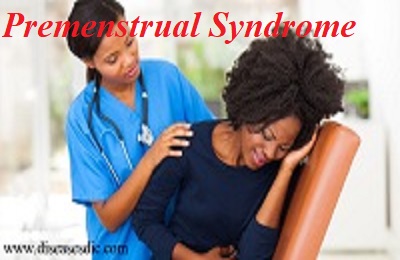Definition
Premenstrual syndrome (PMS) is a combination of emotional, physical, psychological, and mood disturbances that occur after a woman’s ovulation, typically ending with the onset of her menstrual flow. The most common mood-related symptoms are irritability, depression, crying, oversensitivity, and mood swings. The most common physical symptoms are fatigue, bloating, breast tenderness (mastalgia), acne, and appetite changes with food cravings.
Epidemiology
Surveys indicate that PMS is among the most common health problems reported by reproductive age women. Current estimates of the prevalence of clinically significant PMS vary from 12.6% to 31% of menstruating women. Epidemiologic studies have identified approximately 20% of reproductive age women as having moderate to severe PMS. Available data suggest that PMS occurs across cultures at essentially comparable rates.
Risk factors of premenstrual syndrome
A risk factor is anything that increases your chances of getting sick or having a problem. Risk factors for PMS include:
- A family history of PMS.
- PMS becomes more common as women age through their 30s, and symptoms sometimes get worse over time.
- Anxiety, depression, or other mental health problems. This is a significant risk factor for premenstrual dysphoric disorder (PMDD).
- Lack of exercise.
- High stress.
- A diet low in vitamin B6, calcium, or magnesium.
- High caffeine intake.
Causes
- The causes of PMS are not clear. It is linked to the changing hormones during the menstrual cycle. Some women may be affected more than others by changing hormone levels during the menstrual cycle.
- Stress and emotional problems do not seem to cause PMS, but they may make it worse. Diagnosis of PMS is usually based on your symptoms, when they occur, and how much they affect your life.
Symptoms of premenstrual syndrome
PMS often includes both physical and emotional symptoms. Common symptoms are:
- Acne
- Breast swelling and tenderness
- Feeling tired
- Having trouble sleeping
- Upset stomach, bloating, constipation, or diarrhea
- Headache or backache
- Appetite changes or food cravings
- Joint or muscle pain
- Trouble concentrating or remembering
- Tension, irritability, mood swings, or crying spells
- Anxiety or depression Symptoms vary from one woman to another.
If you think you have PMS, keep track of which symptoms you have and how severe they are for a few months. You can use a calendar to write down the symptoms you have each day or you can use a form to track your symptoms. If you go to the doctor for your PMS, take the form at the end of this FAQ with you.
Diagnosis and test
- The most helpful diagnostic tool is the menstrual diary, which documents physical and emotional symptoms over months. If the changes occur consistently around ovulation (mid-menstrual cycle) and persist until the menstrual flow begins, then PMS is probably the accurate diagnosis.
- Keeping a menstrual diary not only helps the health-care professional to make the diagnosis, but also promotes a better understanding by the patient of her own body and moods. Once the diagnosis of PMS is made and understood, the patient can better cope with the symptoms.
- The diagnosis of PMS can be difficult because many medical and psychological conditions can mimic or worsen symptoms of PMS. There are no blood or laboratory tests to determine if a woman has PMS. When laboratory tests are performed, they are used to exclude other conditions that can mimic PMS.
Treatment and medications
Commonly prescribed medications for premenstrual syndrome include:
Antidepressants: Selective serotonin reuptake inhibitors (SSRIs) which include fluoxetine (Prozac, Sarafem), paroxetine (Paxil, Pexeva), sertraline (Zoloft) and others have been successful in reducing mood symptoms. SSRIs are the first line treatment for severe PMS or PMDD. These drugs are generally taken daily. But for some women with PMS, use of antidepressants may be limited to the two weeks before menstruation begins.
Nonsteroidal anti-inflammatory drugs (NSAIDs): Taken before or at the onset of your period, NSAIDs such as ibuprofen (Advil, Motrin IB, others) or naproxen (Aleve, Naprosyn, others) can ease cramping and breast discomfort.
Diuretics: When exercise and limiting salt intake aren’t enough to reduce the weight gain, swelling and bloating of PMS, taking water pills (diuretics) can help your body shed excess fluid through your kidneys. Spironolactone (Aldactone) is a diuretic that can help ease some of the symptoms of PMS.
Hormonal contraceptives: These prescription medications stop ovulation, which may bring relief from PMS symptoms.
Alternative Therapies
Certain vitamins and minerals have been found to help relieve some PMS symptoms. These include:
- Folic acid (400 micrograms)
- Calcium with vitamin D (see chart below for amounts)
- Magnesium (400 milligrams)
- Vitamin B-6 (50 to 100 mg)
- Vitamin E (400 international units)
Preventing Premenstrual Syndrome (PMS)
If your PMS isn’t so bad that you need to see a doctor, some lifestyle changes may help you feel better. Below are some steps you can take that may help ease your symptoms.
- Exercise regularly. Each week, you should get:
- Two hours and 30 minutes of moderate-intensity physical activity;
- One hour and 15 minutes of vigorous-intensity aerobic physical activity; or
- A combination of moderate and vigorous-intensity activity; and
- Muscle-strengthening activities on 2 or more days.
- Eat healthy foods, such as fruits, vegetables, and whole grains.
- Avoid salt, sugary foods, caffeine, and alcohol, especially when you’re having PMS symptoms.
- Get enough sleep. Try to get about 8 hours of sleep each night.
- Find healthy ways to cope with stress. Talk to your friends, exercise, or write in a journal. Some women also find yoga, massage, or relaxation therapy helpful.
- Don’t smoke.

